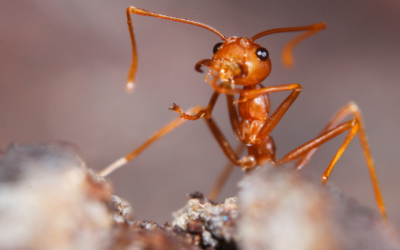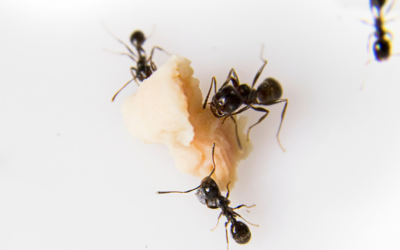In the realm of household pests, carpenter ants stand out for their remarkable woodworking skills and potential damage to homes. Central Texas residents should be well-informed about these wood-destroying insects to effectively protect their properties.
This guide will explore the world of carpenter ants. We will look at their characteristics, behaviors, signs of infestation, and strategies for effective management. All of this information will help us better understand and manage them.
Meet the Carpenter Ants
Carpenter ants, scientifically known as Camponotus spp., are large ants known for their ability to excavate and nest in wood. Let’s explore the key characteristics of these fascinating insects:
Their Characteristics
- Size and Appearance: Carpenter ants are relatively large ants, with workers ranging from 1/4 to 1/2 inch in length. They vary in color, usually black or reddish-brown, and have a segmented body with a distinctive “waist.”
- Wood-Destroying Behavior: Unlike termites that feed on wood, carpenter ants tunnel through it to create nesting galleries. They do not consume the wood but excavate it to establish their colonies, which can lead to structural damage over time.
Habits and Behaviors of Carpenter Ants
- Nesting Preferences: they prefer to establish their nests in moist or decaying wood. Common nesting sites include tree stumps, logs, dead trees, and wooden structures. However, they can also be found nesting in dry wood if moisture sources are nearby.
- Foraging Patterns: Carpenter ants forage for food, which can include sugary substances, insects, and even other ants. They establish foraging trails, usually during nighttime, to collect food for their colonies.
- Satellite Colonies: these pests often establish satellite colonies in addition to their primary nest. Satellite colonies can be found in various parts of a property. This makes it difficult to locate and remove all nesting sites.
Signs of Carpenter Ant Infestation
Identifying signs of a carpenter’s ant infestation is crucial for taking timely action. Look out for the following indicators:
Signs of Infestation
- Carpenter ants create galleries in wood. This produces frass, which looks like sawdust or wood shavings. Accumulations of this material near wooden structures or in crawl spaces may indicate an infestation.
- Audible Sounds: When excavating wood, carpenter ants can produce faint rustling or crunching sounds. Listening to these sounds in quiet areas, especially during nighttime, can help detect their presence.
- Winged Swarmers: Mature colonies produce winged reproductives, known as swarmers, during mating seasons. Spotting these swarmers indoors or near wooden structures suggests an established infestation.
Managing Carpenter Ant Infestations
Effectively managing carpenter ant infestations requires a comprehensive approach. Here are some strategies to consider:
Prevention and Control Methods
- Address Moisture Issues: Moisture attracts these ants. Fix leaks, improve ventilation, and ensure proper drainage around your property to reduce moisture levels and discourage their presence.
- Remove Wood Debris: Eliminate potential nesting sites by removing decaying wood, tree stumps, or other wooden debris from your yard.
- Inspect the exterior of your home for any gaps or openings. Seal any openings you find. This will prevent pests from entering. Pay close attention to areas where utility lines, pipes, or cables enter the building.
- Trim Vegetation: Trim tree branches, shrubs, and plants that come into contact with your home. This prevents carpenter ants from using these as pathways to access your structure.
- Professional Pest Control: If infestations persist or are extensive, consult with a professional pest control service. They can employ targeted treatments, such as baiting or insecticide applications, to eradicate colonies effectively.
855Bugs Will Protect You From Carpenter Ants
Understanding the world of carpenter ants is crucial for Central Texas residents to safeguard their homes from potential structural damage. Recognize the characteristics, behaviors, and signs of infestations. Implement effective prevention and control strategies.
Successfully manage carpenter ant infestations. Stay vigilant. Take proactive measures to protect your property from wood-destroying insects. If needed, seek professional assistance from 855Bugs.




